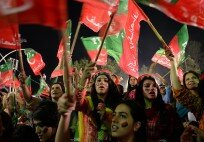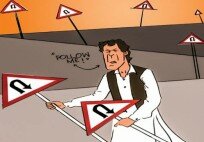By Rasul Bakhsh Rais –
India’s caste and social landscape divides this class further into very narrow bands of parochial loyalties
India has rightly earned a name for regularly conducting its elections even in some of the worst social, cultural and economic conditions that according to many sceptics are not right for democracy.The Indian democratic experience is unique, and in many ways, path-breaking in defying all the old concepts about how and when to ‘pitch’ for democracy.
India, like Pakistan had good institutional heritage and sufficient political endowment in the form of social and political movements, political parties, nationalism, state infrastructure and visionary leadership to mark its ‘destiny’ as a democratic, constitutional state.
Its leaders did not wait for creating the right economic and social conditions through development or by ‘institutionalising democracy’. Rather, their democratic venture was bold, broad and very inclusive from the outset. With all the handicaps of caste, communalism, authoritarian culture, dynastic and corrupt political practices, India has continued to practice democracy in the belief that the civic culture and social capital that support this system would evolve, as they have in mature democratic countries elsewhere.
Indian democracy is better now than it was a few decades back, in terms of participation, sense of empowerment by the common man and inclusivity. New parties, movements and leaders have emerged to successfully challenge the established caste of the ‘elite’ Indian politician or the so called back bone of the political system.
The 2014 general elections in India are very different than the past electoral exercises of this largest democracy in the world. What makes it different are some of the social and political trends that have emerged over the past two decades and these may greatly influence the future Indian political scene. These changes provide a context within which we may relocate the present elections. These trends are: First, and foremost the growth and sheer size of the Indian middle class. It is estimated to be around 200 million strong and mostly, it is highly skilled, educated and economically on the rise. What is likely to be its influence?
In the Western societies, the middle class has provided social stability, strong support to liberal social values and democratic culture. While the Indian middle class might be no less democratic than in other countries, it is generally believed to be conservative. All conservative sections of societies have religious and nationalistic orientations and tend to preserve the tradition however in India’s case it is felt across the board. The informed opinion in India and abroad about this class is that it has strong orientation toward the BJP. How much difference this class will make in determining the outcome of elections is difficult to know. The reason is that the Indian caste and social landscape divides this class further into very narrow bands of parochial loyalties.
Second important development is the growing urbanisation of India, as more people are moving into cities both large and small for better prospects of living standards. Urban population of India, like any other country, is becoming unhinged from old social and political affiliations. The urban population in political attitudes, judge parties and leaders on account of their performance rather than mere old political loyalties. This opens up the urban political space for more competition among the traditional political parties, and also opens the gates wide open for new entrants like the Aam Admi Party.
Third, the old party system of India, which was dominated by the Congress Party has broken down. The party retains the core of its heritage, loyal constituencies of support and charisma of the Nehru dynasty, but it has lost its nation-wide support. It remains a very powerful national party but it can no longer dominate the political process as it was doing during the first half century of Indian independence.
Finally, a large number of regional parties have emerged and developed with the breakdown of national consensus on post-independence economic philosophy and the shared principles of governance. The regional parties rule many states out of 28 states. Even within the Indian states there are smaller parties.
These changes may provide a glimpse of the context within which Indian elections are taking place. There are however two other points one has to keep in mind in understanding the electoral scene and speculating about the possible winners.
First, Indian economy has witnessed a sharp decline in the second tenure of the Congress-led coalition of parties. Growth is down to about 4 per cent and inflation and unemployment are on the rise. Indian electorates are likely to punish the Congress party for poor economic performance. The second issue on the mind of ordinary Indians is widespread corruption among the political elites from states to the union and at all levels. Frequent reports of corruption scandals on the electronic media has generated political dissatisfaction amongst the common man. But like other democracies, peoples make choices at the end and cast their votes. Experience suggests, in repeated cycles of elections, their vote cannot be taken for granted by the political class.
Looking at the four major contenders, which are short of electoral coalitions at the central political stage—Congress, BJP, AAP and the Third Front, a coalition of left-oriented parties—the BJP appears to the front-number.
Narendara Modi has captured the BJP leadership and has greatly dominated the electoral atmosphere of the 2014 Indian elections. With his Hindu nationalistic fervour and relatively better record of economic performance in his Gujarat state, Modi has electrified the conservative constituency and has earned the support of the business class that matters in terms of financial support for the election campaign.
Rahul Gandhi, grandson of Indra Gandhi, a political heir apparent of the Nehru family is leading the Congress campaign. His campaign has focused on unity, secularism, stability and welfare politics, questioning the divisive politics of Modi and BJP. Mr. Gandhi has an uphill task in countering allegations of corruption in his party, inefficiency and economic mismanagement, during the past four years. Opinion polls show that the Congress is quite behind the BJP.
AAP is a new entrant that has shocked both the Congress and the BJP, last year in the Delhi government elections they swept the contested seats. Its founder Arvind Kijriwal and the activists that are from the lower middle class backgrounds, have taken the message of change to every corner of India.
I don’t think the Indian electorate is going to take such a wide swing to bring AAP into power. Such parties emerge as ‘protest movements’, and either they overtime fade or merge into other parties.
Finally the Third Front and the regional parties may claim a bigger chunk in the power game as they bring home more number (lot) of seats and may ultimately hold the balance, if Modi and the BJP fail to sweep the elections. My conservative estimate is that India is going to have another coalition government. We need to wait a few weeks more to see whether it will be the BJP or Congress at the centre of such a coalition, or neither of the two. It is only final play of the saffaron tide of the Indian elections that will determine the future Indian government.
The writer is Director General, Institute of Strategic Studies Islamabad































































































